Columbus, Ohio, Hgh State Clinic, Hgh Injections, Hrt Doctors
Columbus, Ohio Blood Testing Facilities
 Represents a LabCorp blood testing facility
Represents a LabCorp blood testing facility Represents a Quest Diagnostics blood testing facility
Represents a Quest Diagnostics blood testing facility
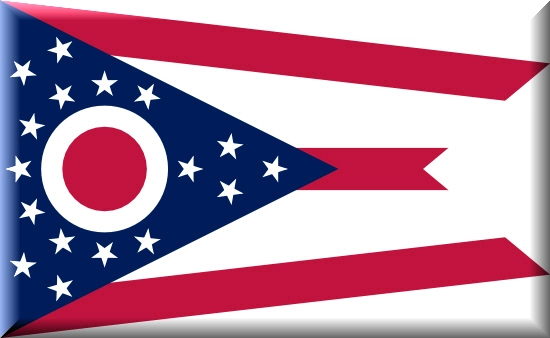
Nearby Labcorp Blood Testing facilities:
- Labcorp Center Distance: 6 m, 4830 Knightsbridge Blvd Ste K, Columbus, Franklin County, OH, 43214
- Labcorp Center Distance: 8 m, 4461 Broadway Ste 300, Grove City, Franklin County, OH, 43123
- Labcorp Center Distance: 9 m, 941 E Johnstown Rd, Gahanna, Franklin County, OH, 43230
- Labcorp Center Distance: 11 m, 56 Westerview Drive, Westerville, Franklin County, OH, 43081
- Labcorp Center Distance: 12 m, 575 Westar Crossing Suite 103, Westerville, Delaware County, OH, 43081
- Labcorp Center Distance: 13 m, 664 N Hill Rd, Pickerington, Fairfield County, OH, 43147
- Labcorp Center Distance: 23 m, 116 Morris Rd, Circleville, Pickaway County, OH, 43113
- Labcorp Center Distance: 24 m, 562 W Central Ave, Delaware, Delaware County, OH, 43015
- Labcorp Center Distance: 29 m, 95 S Terrace Ave, Newark, Licking County, OH, 43055
- Labcorp Center Distance: 42 m, 140 West Main St. Suite 203, Springfield, Clark County, OH, 45502
- Labcorp Center Distance: 51 m, 7774 Dayton Springfield Rd, Fairborn, Clark County, OH, 45324
- Labcorp Center Distance: 57 m, 3464 Pentagon Park Blvd Ste E, Beavercreek, Greene County, OH, 45431
- Labcorp Center Distance: 58 m, 564 S Trimble Rd Ste B, Mansfield, Richland County, OH, 44906
- Labcorp Center Distance: 60 m, 1275 N High St, Hillsboro, Highland County, OH, 45133
- Labcorp Center Distance: 63 m, 6625 Centerville Business Park, Centerville, Montgomery County, OH, 45459
- Labcorp Center Distance: 65 m, 1 Elizabeth Pl Ste 250, Dayton, Montgomery County, OH, 45408
- Labcorp Center Distance: 69 m, 415 Byers Rd Ste 200, Miamisburg, Montgomery County, OH, 45342
- Labcorp Center Distance: 73 m, 25800 S Main Street (St Rt 41), Peebles, Adams County, OH, 45660
- Labcorp Center Distance: 78 m, 1012 Bellefontaine Ave, Lima, Allen County, OH, 45801
- Labcorp Center Distance: 79 m, 855 W Market St, Lima, Allen County, OH, 45805
- Labcorp Center Distance: 81 m, 721 Reading Rd, Mason, Warren County, OH, 45040
- Labcorp Center Distance: 87 m, 83 Powhatton Dr, Milford, Clermont County, OH, 45150
- Labcorp Center Distance: 88 m, 9030 Montgomery Rd, Cincinnati, Hamilton County, OH, 45242
- Labcorp Center Distance: 89 m, 272 Benedict Ave, Norwalk, Huron County, OH, 44857
- Labcorp Center Distance: 90 m, 1212 Garfield Ave Ste 101, Parkersburg, Wood County, WV, 26101
- Labcorp Center Distance: 91 m, 903 Nw Washington Blvd Ste C, Hamilton, Butler County, OH, 45013
- Labcorp Center Distance: 92 m, 500 Ohio Pike, Cincinnati, Clermont County, OH, 45255
- Labcorp Center Distance: 93 m, 780 Nilles Rd B, Fairfield, Butler County, OH, 45014
Nearby Quest Blood Testing facilities:
- Quest Center Distance: 6 m, 50 Old Village Rd, Columbus, Franklin County, OH, 43228-1538
- Quest Center Distance: 9 m, 99 N Brice Rd North, Columbus, Franklin County, OH, 43213-6510
- Quest Center Distance: 10 m, 5130 Bradenton Ave, Dublin, Franklin County, OH, 43017-7557
- Quest Center Distance: 41 m, 2355 Derr Rd, Springfield, Clark County, OH, 45503-2439
- Quest Center Distance: 42 m, 1069 Delaware Ave, Marion, Marion County, OH, 43302-6459
- Quest Center Distance: 52 m, 1214 N Monroe Dr, Xenia, Greene County, OH, 45385-1622
- Quest Center Distance: 54 m, 1836 Commerce Center Blvd, Fairborn, Greene County, OH, 45324-6337
- Quest Center Distance: 57 m, 2601 Commons Blvd, Beavercreek, Greene County, OH, 45431-3831
- Quest Center Distance: 59 m, 339 Cline Ave, Mansfield, Richland County, OH, 44903-1072
- Quest Center Distance: 62 m, 2350 Miami Valley Drive, Centerville, Montgomery County, OH, 45459-4778
- Quest Center Distance: 63 m, 900 S. Dixie Drive, Vandalia, Montgomery County, OH, 45377-2657
- Quest Center Distance: 64 m, 1 Wyoming Street, Dayton, Montgomery County, OH, 45409-2722
- Quest Center Distance: 65 m, 1 Elizabeth Pl, Dayton, Montgomery County, OH, 45417-3445
- Quest Center Distance: 68 m, 5 W Wenger Rd, Englewood, Montgomery County, OH, 45322-2723
- Quest Center Distance: 70 m, 630 N Main St, Springboro, Warren County, OH, 45066-7519
- Quest Center Distance: 78 m, 62 N Breiel Blvd, Middletown, Butler County, OH, 45042-3804
- Quest Center Distance: 83 m, 9313 S Mason Montgomery Rd, Mason, Warren County, OH, 45040-8826
- Quest Center Distance: 90 m, 8250 Kenwood Crossing Way, Cincinnati, Hamilton County, OH, 45236-3670
- Quest Center Distance: 92 m, 1426 Main St, Hamilton, Butler County, OH, 45013-1004
- Quest Center Distance: 93 m, 5130 Pleasant Ave, Fairfield, Butler County, OH, 45014-2611
- Quest Center Distance: 94 m, 7235 Beechmont Ave, Cincinnati, Hamilton County, OH, 45230-4116
- Quest Center Distance: 98 m, 2475 W Galbraith Rd, Cincinnati, Hamilton County, OH, 45239-4369
Columbus Hormone Replacement Therapy Services
The Conscious Evolution Institute is a Licensed and Board Certified Hormone Clinic which dutifully serves the entire Columbus, Ohio metropolitan area. Our physicians and medical specialists are highly trained in cutting edge Hormone Therapies designed to optimize your Hormone Balance and help you look and feel your best. If you are interested in finding out if Hormone Replacement is right for you, we encourage you to contact us by phone or fill out the contact form on this page, and we can provide you with a no-cost consultation regarding the services we provide.
If, after this consultation, you are interested in having your Hormone Levels analyzed, we can arrange for you to meet with one of our affiliate doctors in the Columbus area to undergo a physical and provide a blood sample which will be analyzed in order to determine your health state and your potential need for the Hormone Treatments that we offer. Don't let your health go into a state of decline as a result of Hormone Deficiency. Contact us and make an appointment to get the potentially lifechanging Hormone Therapy that you deserve!
Columbus Testosterone Therapy Treatments for Andropause and Testosterone Deficiency
Low-T is a medical condition that men are more likely to experience with every year that they grow older. Men need Testosterone because it helps them maintain physiological balance which amplifies health and wellness. Testosterone promotes healthy metabolism and body composition, psychological balance, and sexual health, while also being an important factor in cardiovascular health.
Testosterone Levels top out at around the age of 30, and begin to fall slowly as men enter their 40s, 50s, and beyond. When Testosterone Production reaches a level where problems start to arise, this is known as Andropause. Testosterone Replacement Therapy can mitigate the effects of Andropause and Age-Related Testosterone Deficiency, by restoring Testosterone Levels to those associated with the late teens and early twenties, when you were at your physiological peak. Ask our specialists about the many Low-T Treatments that we provide, including Testosterone Patches, Testosterone Creams, and Injectable Testosterone.
Columbus Human Growth Hormone Replacement for HGH Deficiency
Human Growth Hormone Deficiency can affect both men and women, and becomes more likely with age. In fact, many researchers hypothesize that Growth Hormone Deficiency is one of the changes which exacerbate the aging process and increase the likelihood of experiencing issues such as obesity, heart disease, diabetes, osteoporosis, and Alzheimer's associated with aging. HGH is produced by the human Pituitary, and the pituitary pumps out less and less Human Growth Hormone with every passing year.
Symptoms of HGH Deficiency include weight gain, loss of muscle mass, fatigue, increased risk of illness, poor sleep, slower physical rehabilitation, depression, and cognitive decline. With Injectable HGH Therapy for Growth Hormone Deficiency, it is possible to boost HGH Levels to a level at which the body's physiological processes are able to function at peak capacity.
Columbus Sermorelin Therapy for HGH Deficiency
Growth Hormone Therapy is highly effective at treating HGH Deficiency, but there is another option available for patients, that may be a better option for many, and it is called Sermorelin Acetate. Sermorelin Acetate is a Recombinant Hormone Therapy designed to perfectly mimic the function of a natural hormone known as GHRH, which is produced by the human hypothalamus in order to promote the healthy secretion of Human Growth Hormone.
Because the body has natural methods to mediate the production of HGH via Sermorelin and GHRH, the body produces exactly as much Human Growth Hormone as it needs, which makes it safer and more effective than HGH for many patients. Furthermore, Sermorelin is less expensive to produce, and that financial benefit is passed on to the patient. Lastly, Sermorelin is available for Off-Label prescription, which means that, if your doctor feels that you can benefit from Sermorelin, they are free to prescribe it to you, even if you can't legally be prescribed Human Growth Hormone. Call us to learn more about the benefits of Sermorelin Acetate!
Columbus HCG Diet for Weight Loss
Another of the many fine Hormone Therapy Programs that we provide is HCG Therapy. HCG stands for Human Chorionic Gonadotropin, and this hormone has been found to effectively encourage weight loss when used as a Physician-Mediated Medical Treatment in combination with caloric restriction. HCG can help patients lose as much as seven pounds every seven days, both while preventing hunger and encouraging the body to burn fat while sustaining muscle mass and energy levels. HCG Injections are a great option for patients that have been failed by more mainstream diets in the past, or those that are looking to avoid Weight Loss Surgery!
Columbus, Ohio Information
Columbus is located in the heart of the state of Ohio, and is both the most populous city in the state of Ohio as well as the capital of the state. Columbus has many nicknames, including The Biggest Small Town in America, Arch City, and the Discovery City. Columbus is widely considered one of the best cities to live in in the entire midwest, as a result of its strong economy and high quality of living.
As with many other state capitals in the United States, Columbus has a strong and diversified economy, with specific strengths in the fields of technology, health care, defense, finance, and education. There are a number of fine institutions of learning in the Columbus area, the most notable of which being the Ohio State University. Perhaps as a result of the city's huge presence in collegiate athletics, Columbus is only home to two major professional sports team—The Columbus Crew of Major League Soccer and the Columbus Blue Jackets of the National Hockey League. The mascot of the Ohio State University is the Buckeye, and the OSU athletic program is one the founding members of the Big Ten Conference.
There are many things to see and do in Columbus, and one of the most well-regarded attractions in the city is the Columbus Zoo and Aquarium. For visitors more interested in art and history, Columbus is home to a number of excellent museums and landmarks, including the Franklin Park Conservatory, The Wexler Center of the Arts, and the Columbus Museum of Art.
All About Columbus, Ohio Geographic Area
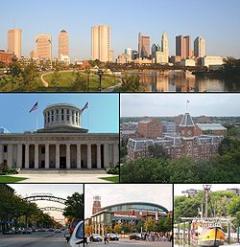
Columbus is the capital of and the largest city in the U.S. state of Ohio. The broader metropolitan area encompasses several counties and is the third largest in Ohio behind those of Cleveland and Cincinnati. Columbus is the fifteenth largest city in the United States of America. It is the county seat of Franklin County, yet the city has expanded and annexed portions of adjoining Delaware County and Fairfield County. Named for explorer Christopher Columbus, the city was founded in 1812 at the confluence of the Scioto and Olentangy rivers, and assumed the functions of state capital in 1816. The city has a diverse economy based on education, government, insurance, banking, fashion, defense, aviation, food, clothes, logistics, steel, energy, medical research, health care, hospitality, retail, and technology. Modern Columbus has emerged as a technologically sophisticated city. It is home to the world's largest private research and development foundation, the Battelle Memorial Institute; CAS, or Chemical Abstracts Service, the world's largest clearinghouse of chemical information; NetJets, the world's largest fractional ownership jet aircraft fleet; and The Ohio State University, the nation's largest campus. In 2012, Columbus was ranked in BusinessWeek's top 50 best cities in America.
In 2009, BusinessWeek named the city as the best place in the country to raise a family. Forbes Magazine in 2008 ranked the city as the no. 1 up-and-coming tech city in the nation, and the city was ranked a top ten city by Relocate America in 2010. In 2007, fDi Magazine ranked the city no. 3 in the U.S. for cities of the future, and the Columbus Zoo and Aquarium was rated no. 1 in 2009 by USA Travel Guide.
In 2008, MarketWatch named Columbus as the 7th best place to do business in the nation. In 2011, the city had five corporations named to the U.S. Fortune 500 list including Nationwide Mutual Insurance Company, American Electric Power, Limited Brands, Momentive Specialty Chemicals, and Big Lots. Major foreign corporations operating or with divisions in the city include Germany-based Siemens and Roxane Laboratories, Finland-based Vaisala, Tomasco Mulciber Inc., and A Y Manufacturing, as well as Switzerland-based ABB Group and Mettler Toledo.
The population of the city was 787,033 at the 2010 census, making it the most populous city in Ohio. Although Columbus was the 15th largest city in the United States, it has only the 32nd largest metropolitan area, with 1,836,536 residents. It is the fourth most populous state capital in the United States. Census estimates from 2008 indicate that roughly 116,000 of the city's residents are foreign-born, accounting for 82% of the new residents between 2000 and 2006. According to the U.S. Census, the Columbus Combined Statistical Area (which also includes Marion and Chillicothe) has a population of 2,031,229.

The region where modern-day Columbus is found was once called the Ohio Country, under the control of the French Empire through the Vice-royaute of New France. European traders flocked to the area, in the interests of the fur trade.
The area was consistently caught between warring factions, including Native American and European interests. In the 1740s Pennsylvania traders had overrun the territory until the French forcibly evicted them. In the early 1750s George Washington was sent to the Ohio Country by the Ohio company to survey, and the fight for control of the territory would spark Europe's Seven Year's War with the French and Indian War.
The Treaty of Paris ceded the country to the British Empire in 1763. During this period the country was routinely engaged in turmoil, with massacres and battles occurring.
Following the American Revolution, the Ohio Country became part of the Virginia Military District under the control of the United States. Colonialists from the East Coast moved in, but rather than finding an empty frontier, they encountered people of the Miami, Delaware, Wyandot, Shawnee, and Mingo nations, as well as European traders. The tribes resisted expansion by the fledgling United States, resulting in years of bitter conflict. The decisive battle of Fallen Timbers resulted in the Treaty of Greenville, which finally opened the way for new settlements. By 1797, a young surveyor from Virginia named Lucas Sullivant had founded a permanent settlement on the west bank of the forks of the Scioto River. An admirer of Benjamin Franklin, Sullivant chose to name his frontier village "Franklinton". Although the location was desirable in its proximity to navigable rivers, Sullivant was initially foiled when, in 1798, a large flood wiped out the newly formed settlement. He persevered, and the village was rebuilt.
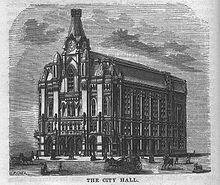
After Ohio achieved statehood in 1803, political infighting among Ohio's more prominent leaders resulted in the state capital moving from Chillicothe to Zanesville and back again. The state legislature finally decided that a new capital city, located in the center of the state, was a necessary compromise. Columbus was chosen as the site for the new capital because of its central location within the state and access by way of major transportation routes (primarily rivers) at that time. The legislature chose it as Ohio's capital over a number of other competitors, including Franklinton, Dublin, Worthington, and Delaware. Prior to the state legislature's decision in 1812, Columbus did not exist. The city was designed from the first as the state's capital, preparing itself for its role in Ohio's political, economic, and social life. Named in honor of Christopher Columbus, the capital city was founded on February 14, 1812, on the "High Banks opposite Franklinton at the Forks of the Scioto known as Wolf's Ridge." At the time, this area was a dense forestland, used only as a hunting ground.
The "Burough of Columbus" [sic] was officially established on February 10, 1816. Nine people were elected to fill the various positions of Mayor, Treasurer, and others. Although the recent War of 1812 had brought prosperity to the area, the subsequent recession and conflicting claims to the land threatened the success of the new town. Early conditions were abysmal with frequent bouts of fevers and an outbreak of cholera in 1833.
The National Road reached Columbus from Baltimore in 1831, which complemented the city's new link to the Ohio and Erie Canal and facilitated a population boom. A wave of immigrants from Europe resulted in the establishment of two ethnic enclaves on the outskirts of the city. A significant Irish population settled in the north along Naghten Street (presently Nationwide Boulevard), while the Germans took advantage of the cheap land to the south, creating a community that came to be known as Das Alte Sudende (The Old South End). Columbus's German population constructed numerous breweries, Trinity Lutheran Seminary, and Capital University.
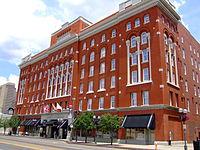
With a population of 3500, Columbus was officially chartered as a city on March 3, 1834. The legislature carried out a special act on that day, which granted legislative authority to the city council and judicial authority to the mayor. Elections were held in April of that year, with voters choosing one John Brooks as the first mayor. Columbus annexed the separate city of Franklinton in 1837.
In 1850 the Columbus and Xenia Railroad became the first railroad to enter the city, followed by the Cleveland, Columbus and Cincinnati Railroad in 1851. The two railroads built a joint Union Station on the east side of High Street just north of Naghten (then called North Public Lane). Rail traffic into Columbus increased aeby 1875 Columbus was served by eight railroads, and a new, more elaborate station was built.
On January 7, 1857, the Ohio Statehouse finally opened to the public after 18 years of construction.
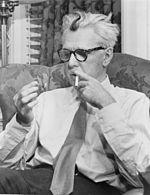
During the Civil War, Columbus was a major base for the volunteer Union Army that housed 26,000 troops and held up to 9,000 Confederate prisoners of war at Camp Chase located at what is now the Hilltop neighborhood of west Columbus. Over 2,000 Confederate soldiers remain buried at the site, making it one of the largest Confederate cemeteries in the North. North of Columbus, along the Delaware Road, the Regular Army established Camp Thomas, where the 18th U.S. Infantry was organized and trained.
By virtue of the Morrill Land-Grant Colleges Act, the Ohio Agricultural and Mechanical College (which became The Ohio State University) was founded in 1870 on the former estate of William and Hannah Neil.
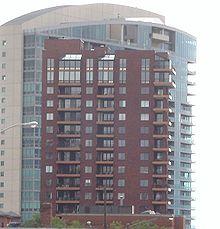
By the end of the 19th century, Columbus saw the rise of several major manufacturing businesses. The city became known as the "Buggy Capital of the World", thanks to the presence of some two dozen buggy factories, notably the Columbus Buggy Company, which was founded in 1875 by C.D. Firestone. The Columbus Consolidated Brewing Company also rose to prominence during this time, and it may have had achieved even greater success were it not for the influence of the Anti-Saloon League, based in neighboring Westerville. In the steel industry, a forward-thinking man named Samuel P. Bush presided over the Buckeye Steel Castings Company. Columbus was also a popular location for the organization of labor. In 1886, Samuel Gompers founded the American Federation of Labor in Druid's Hall on S. Fourth Street, and in 1890 the United Mine Workers of America was founded at old City Hall. In 1894, James Thurber, who would go on to an illustrious literary career in Paris and New York City, was born in the city. Today the Ohio State's theater department has a performance center named in his honor, and his youthful home near the Discovery District is on the list of National Register of Historic Places.
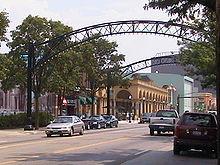
"The Columbus Experiment" was an internationally recognized environmental project in 1908, which saw the construction of the first water plant in the world to apply filtration and softening, designed and invented by Hoover brothers, Clarence and Charles. Those working to construct the project included Jeremiah O'Shaughnessy, name-bearer of the Columbus metropolitan area's O'Shaughnessy Dam. This invention helped drastically reduce typhus deaths. These designs are still in use today.
Columbus earned one of its nicknames, "The Arch City", because of the dozens of wooden arches that spanned High Street at the turn of the 20th century. The arches illuminated the thoroughfare and eventually became the means by which electric power was provided to the new streetcars. The arches were torn down and replaced with cluster lights in 1914, but were reconstructed from metal in the Short North district in 2002 for their unique historical interest.
On March 25, 1913, a catastrophic flood devastated the neighborhood of Franklinton, leaving over ninety people dead and thousands of West Side residents homeless. To prevent future flooding, the Army Corps of Engineers recommended widening the Scioto River through downtown, constructing new bridges, and building a retaining wall along its banks. With the strength of the post-WWI economy, a construction boom occurred in the 1920s, resulting in a new Civic Center, the Ohio Theatre, the American Insurance Union Citadel, and, to the north, a massive new Ohio Stadium. Although the American Professional Football Association was founded in Canton in 1920, its head offices moved to Columbus in 1921 and remained in the city until 1941. In 1922, the association's name was changed to the National Football League.
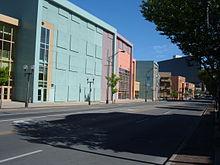
The effects of the Great Depression were somewhat less severe in Columbus, as the city's diversified economy helped it fare marginally better than its Rust Belt neighbors. World War II brought a tremendous number of new jobs to the city, and with it another population surge. This time, the majority of new arrivals were migrants from the "extraordinarily depressed rural areas" of Appalachia, who would soon account for more than a third of Columbus' rising population. In 1948, the Town and Country Shopping Center opened in suburban Whitehall, and it is now regarded as one of the first modern shopping centers in the United States.

The construction of the interstate highway signaled the arrival of rapid suburb development in central Ohio. In order to protect the city's tax base from this suburbanization, Columbus adopted a policy of linking sewer and water hookups to annexation to the city. By the early 1990s, Columbus had grown to become Ohio's largest city in both land area and in population.
Efforts to revitalize downtown Columbus have had some success in recent decades, though like most major American cities, some architectural heritage was lost in the process. In the 1970s, landmarks such as Union Station and the Neil House Hotel were razed to construct high-rise offices and big retail space. The National City Bank building was constructed in 1977, as well as the Nationwide Plazas and other towers that sprouted during this period. The construction of the Greater Columbus Convention Center has brought major conventions and trade shows to the city. The Scioto Mile is a showcase park that is being developed along the riverfront, an area which has already seen the development of Miranova Corporate Center and The Condominiums at North Bank Park. Corporate interests have developed Capitol Square, including the local NBC affiliate locating at the corner of Broad and High.
The 2010 United States foreclosure crisis has forced the city to purchase numerous foreclosed, vacant properties ae either to renovate them or to demolish them ae at a cost of tens of millions of dollars. As of February 2011, there are an unprecedented 6,117 vacant properties in Columbus, according to city officials.
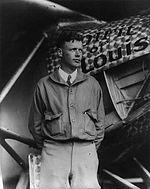
In 1907, 14-year old Cromwell Dixon built the "SkyCycle," a pedal-powered blimp, which he flew at Driving Park.
In 1910, the world's first commercial cargo flight occurred when one of the Wright Brothers' exhibition pilots, Phillip Parmalee, flew two packages containing 88 kilograms of silk from Dayton to Columbus in a Wright Model B, a distance of 70 miles (110 km).
Less than 20 years later, Port Columbus Airport became the axis of a coordinated rail-to-air transcontinental system that moved passengers from the East Coast to the West, with TAT, which later became TWA, providing the commercial service, following Charles Lindbergh's promotion of Columbus to the nation for such a hub. Following the failure of a bond levy in 1927 to build the airport, Lindbergh personally campaigned in the city in 1928, and the next bond levy passed that year. On July 8, 1929 the airport opened for business with the inaugural TAT west-bound flight from Columbus to Waynoka, Oklahoma. Among the 19 passengers on that flight was Amelia Earhart, with Henry Ford and Harvey Firestone attending the opening ceremonies.
In 1964, Ohio native Geraldine Fredritz Mock became the first woman to fly around the world, leaving from Columbus and piloting the Spirit of Columbus. Her flight lasted nearly a month, and set a record for speed for planes under 3858 pounds.
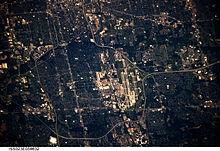
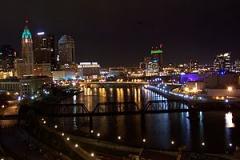
The confluence of the Scioto and Olentangy rivers occurs just west of downtown Columbus. Several smaller tributaries course through the Columbus metro area, including Alum Creek, Big Walnut Creek, and Darby Creek. Columbus is considered to have relatively flat topography thanks to a large glacier that covered most of Ohio during the Wisconsin Ice Age. However, there are sizable differences in elevation through the area, with the high point of Franklin County being 1,132 ft (345 m) above sea level near New Albany, and the low point being 670 ft (200 m) where the Scioto River leaves the county near Lockbourne. Numerous ravine areas near the rivers and creeks also help give some variety to the landscape. Tributaries to Alum Creek and the Olentangy River cut through shale, while tributaries to the Scioto River cut through limestone.
The region's climate is transitional between humid continental (Koppen climate classification Dfa) and humid subtropical (Koppen Cfa), characterized by hot, muggy summers and cold, dry winters. Winter snowfall is relatively light, since the city is not in the typical path of strong winter lows, such as the Nor'easters that strike cities farther east. It is also too far south and west for lake-effect snow from Lake Erie to have much effect, although the lakes to the North do contribute to long stretches of cloudy spells in winter.
The hottest temperature ever recorded in Columbus was 106 °F (41 °C), which occurred twice during the Dust Bowl of the 1930s aeonce on July 21, 1934, and again on July 14, 1936. The coldest temperature ever recorded was na22 °F ( na30 °C), occurring on January 19, 1994. Columbus is subject to severe weather typical to the Midwestern United States. Severe thunderstorms can bring frequent lightning, large hail and Tornadoes, especially during the spring and sometimes through fall, a recent one of which occurred on October 11, 2006 and caused F2 damage. Floods, blizzards, and Ice Storms can also occur from time to time.
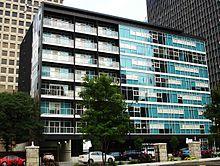
According to the 2010 Census, the racial composition of Columbus was as follows:
As of the census of 2000, there were 711,470 people, 301,534 households, and 165,240 families residing in the city. The population density was 3,383.6 people per 1 sq mi (2.6 km2). There were 327,175 housing units at an average density of 1,556.0 per 1 sq mi (2.6 km2). The racial makeup of the city was 67.93% White, 24.47% Black or African American, 0.29% Native American, 3.44% Asian, 0.05% Pacific Islander, 1.17% from other races, and 2.65% from two or more races. 2.46% of the population were Hispanic or Latino of any race. The five most common ancestries reported were German (19.4%), Irish (11.7%), English (7.9%), Polish (7.2%), and Italian (5.0%).
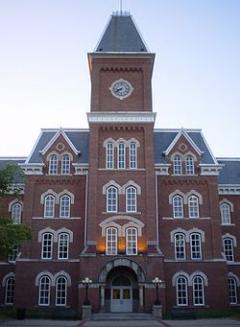
There were 301,534 households out of which 28.0% had children under the age of 18 living with them, 36.1% were married couples living together, 14.5% had a female householder with no husband present, and 45.2% were non-families. 34.1% of all households were made up of individuals and 7.0% had someone living alone who was 65 years of age or older. The average household size was 2.30 and the average family size was 3.01.
The age distribution is 24.2% under the age of 18, 14.0% from 18 to 24, 35.1% from 25 to 44, 17.9% from 45 to 64, and 8.9% who were 65 years of age or older. The median age was 31 years. For every 100 females there were 94.6 males. For every 100 females age 18 and over, there were 91.9 males.
The median income for a household in the city was $37,897, and the median income for a family was $47,391. Males had a median income of $35,138 versus $28,705 for females. The per capita income for the city was $20,450. About 10.8% of families and 14.8% of the population were below the poverty line, including 18.7% of those under age 18 and 10.9% of those age 65 or over.

In 1900, whites made up 93.4% of the population. The Columbus metropolitan area has experienced several waves of immigration in the 20th century and into the 21st, including groups from mainland China, Europe, Taiwan, Vietnam, Russia, Japan, Somalia, India, and ongoing immigration from Mexico and other Latin American countries. Many other countries of origin are represented as well, with much of this related to the international draw of Ohio State University. 2008 estimates indicate that roughly 116,000 of the city's residents are foreign-born, accounting for 82% of the new residents between 2000 ae2006 at a rate of 105 per week. 40% of the immigrants have come from Asia, 23% from Africa, 22% from Latin America, and 13% from Europe.
Due to its demographics, which include a mix of races and a wide range of incomes, as well as urban, suburban, and nearby rural areas, Columbus is considered to be a "typical" American city, and has been used as a test market for new products by retail and restaurant chains. However, newer studies suggest that Columbus may no longer accurately mirror the U.S. population as a whole.
Columbus is home to a proportional LGBT community, with an estimated 34,952 gay, lesbian, or bisexual residents. It has been rated as one of the best cities in the country for gays and lesbians to live, and also as the most underrated gay city in the country. In July 2012, the Columbus City Council unanimously passed a domestic partnership registry.
Columbus was ranked as the 15th most literate city in the country in 2008 by Central Connecticut State University, and the 19th best educated. In 2006, Columbus was ranked by CNN Money as the 8th best big city in the country to live in.
In 2010, the city was ranked as the second most manly city in the country by Sperling's, up from number 7 in 2009. Also, that same year, the Dole Nutrition Institute named Columbus as a top city for salad consumption.

Arena District

Brewery District

Clintonville

Downtown Columbus, Ohio

East Columbus, Ohio

Easton
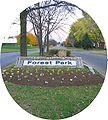
Forest Park

Franklinton

German Village

Harrison West
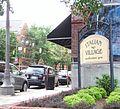
Italian Village

King-Lincoln Bronzeville

Merion Village

Near East Side, Columbus, Ohio

Northland

Old Oaks

Olde Towne East

The Short North

University District

Uptown

Victorian Village
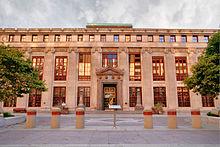
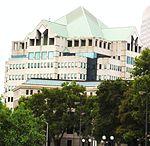
The city is administered by a mayor and a seven-member unicameral council elected in two classes every two years to four-year terms. The mayor appoints the director of safety and the director of public service. The people elect the auditor, municipal court clerk, municipal court judges and city attorney. A charter commission, elected in 1913, submitted, in May 1914, a new charter offering a modified Federal form, with a number of progressive features, such as nonpartisan ballot, preferential voting, recall of elected officials, the referendum, and a small council elected at large. The charter was adopted, effective January 1, 1916. The current mayor of Columbus is Michael B. Coleman.
The City of Columbus is policed by a Municipal Police Department, the Columbus Division of Police. According to the CQ Press in 2009, Columbus ranked as the 38th most dangerous city in the United States, though it has never been ranked among the top 25. This ranking is based on crime statistics compiled by the Federal Bureau of Investigation as weighted by the CQ Press. In 2011, Columbus had 92 homicides, which was an average year for the city, and 658 violent crimes for every 100,000 people. A crime incident map, updated daily, is available for Columbus, Ohio. including crime location, type and detailed information.
The city of Columbus is protected 24/7, 365 by the paid firefighters of the city of Columbus Division of Fire. The Division of Fire operates out of 34 Fire Stations, located throughout the city in 7 Battalions, under the command of 7 Battalion Chiefs per shift. The Division of Fire also operates a fire apparatus fleet of 36 Engine Companies, 15 Ladder Companies, 5 Rescue Companies, 34 Medic Units, 7 EMS Commanders, 1 Haz-Mat. Unit, 1 Haz-Mat. Trailer, 2 Bomb Squad Units, 12 Rescue Boats, 1 Safety Officer's Unit, 1 Incident Support Unit, 1 Tow/Maintenance Unit, and numerous other special, support, and reserve units.
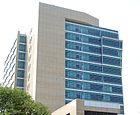
Columbus has a generally strong and diverse economy based on education, insurance, banking, fashion, defense, aviation, food, logistics, steel, energy, medical research, health care, hospitality, retail, and technology. Overall, it was ranked as one of the top 10 best big cities in the country in 2010, according to Relocate America, a real estate research firm. MarketWatch ranked Columbus and its metro area as the No. 7 best place in the country to operate a business in 2008. In 2012, Forbes Magazine ranked the city as the best city for working moms. In 2007, the city was ranked No. 3 in the United States by fDi magazine for "Cities of the Future", and No. 4 for most business-friendly in the country. Columbus was ranked as the seventh strongest economy in the United States in 2006, and the best in Ohio, according to Policom Corp. In 2011, the Columbus metropolitan area's GDP was $94.7 billion, up from $90 billion in 2009, up from $85.5 billion in 2006, $75.43 billion in 2005, and $69.98 billion in 2001.
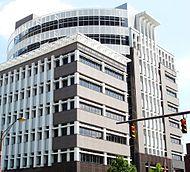
During the recession beginning in late 2007, Columbus' economy was not impacted as much as the rest of the country, due to decades of diversification work by long-time corporate residents, business leaders, and political leaders. The current administration of mayor Michael B. Coleman has continued this work, although the city faced financial turmoil and had to increase taxes, due in part to alleged fiscal mismanagement. As Columbus is the state capital, there is a large government presence in the city. Including city, county, state, and federal employers, government jobs provide the largest single source of employment within Columbus.
In 2011, the city had five corporations named to the U.S. Fortune 500 list including Nationwide Mutual Insurance Company, American Electric Power, Limited Brands, Momentive Specialty Chemicals, and Big Lots, with Cardinal Health located in suburban Dublin. Other major employers in the area include numerous schools (for example, The Ohio State University) and hospitals, hi-tech research and development including the Battelle Memorial Institute, information/library companies such as OCLC and Chemical Abstracts, financial institutions such as JP Morgan Chase and Huntington Bancshares, as well as Owens Corning and Wendy's. Major foreign corporations operating or with divisions in the city include Germany-based Siemens and Roxane Laboratories, Finland-based Vaisala, Japan-based Techneglas, Inc. (Techneglas closed operations in Columbus), Tomasco Mulciber Inc., A Y Manufacturing, as well as Switzerland-based ABB Group and Mettler Toledo.
The city's street plan originates downtown and extends into the old-growth neighborhoods, following a grid pattern with the intersection of High Street (running north aesouth) and Broad Street (running east aewest) at its center. North-South streets run 12 degrees west of due North, parallel to High Street; the Avenues (vis. Fifth Avenue, Sixth Avenue, Seventh Avenue, and so on.) run east aewest. The address system begins its numbering at the intersection of Broad and High, with numbers increasing in magnitude with distance from Broad or High. Numbered Avenues begin with First Avenue, about 1.25 mi (2.01 km) north of Broad Street, and increase in number as one progresses northward. Numbered Streets begin with Second Street, which is two blocks west of High Street, and Third Street, which is a block east of High Street, then progress eastward from there. Even-numbered addresses are on the north and east sides of streets, putting odd addresses on the south and west sides of streets. A difference of 700 house numbers means a distance of about 1 mi (1.6 km) (along the same street). For example, 351 W 5th Avenue is approximately .5 mi (0.80 km) west of High Street on the south side of Fifth Avenue. Buildings along north aesouth streets are numbered in a similar manner: the building number indicates the approximate distance from Broad Street, the prefixes adN ao and adS ao indicate whether that distance is to measured to the north or south of Broad Street and the street number itself indicates how far the street is from the center of the city at the intersection of Broad and High.
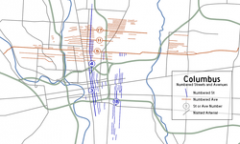
This street numbering system does not hold true over a large area. The area served by numbered Avenues runs from about Marble Cliff to South Linden to the Airport, and the area served by numbered Streets covers Downtown and nearby neighborhoods to the east and south, with only a few exceptions. There are quite few intersections between numbered Streets and Avenues. Furthermore, named Streets and Avenues can have any orientation. For example, while all of the numbered avenues run east aewest, perpendicular to High Street, many named, non-numbered avenues run north aesouth, parallel to High. The same is true of many named streets: while the numbered streets in the city run north aesouth, perpendicular to Broad Street, many named, non-numbered streets run east aewest, perpendicular to High Street.
The addressing system, however, covers nearly all of Franklin County, with only a few older suburbs retaining self-centered address systems. The address scale of 700 per mile results in addresses approaching, but not usually reaching, 10,000 at the county's borders.
Other major, local roads in Columbus include Main Street, Morse Road, Dublin-Granville Road (SR-161), Cleveland Avenue/Westerville Road (SR-3), Olentangy River Road, Riverside Drive, Sunbury Road, Fifth Avenue and Livingston Avenue.
Columbus is bisected by two major Interstate Highways, Interstate 70 running east aewest, and Interstate 71 running north to roughly southwest. The two Interstates combine downtown for about 1.5 mi (2.4 km) in an area locally known as "The Split", which is a major traffic congestion point within Columbus, especially during rush hour. U.S. Highway 40, aka National Road, runs east aewest through Columbus, comprising Main Street to the east of downtown and Broad Street to the west. It is also widely recognized as the nation's first highway. U.S. Highway 23 runs roughly north aesouth, while U.S. Highway 33 runs northwest-to-southeast. The Interstate 270 Outerbelt encircles the vast majority of the city, while the newly redesigned Innerbelt consists of the Interstate 670 spur on the north side (which continues to the east past the Airport and to the west where it merges with I-70), State Route 315 on the west side, the I-70/71 split on the south side, and I-71 on the east. Due to its central location within Ohio and abundance of outbound roadways, nearly all of the state's destinations are within a 2-hour drive of Columbus.
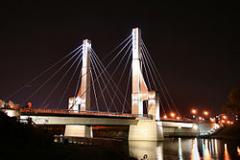
The Columbus riverfront hosts a few notable bridges which have been built in recent years. The 700 ft (210 m) Main Street Bridge opened on July 30, 2010 and is the first bridge of its kind in North America. The bridge is located directly south of COSI on the Scioto river, featuring three lanes of one-way traffic and another separated lane for pedestrians and bikes. The Rich Street Bridge which is scheduled to open in August 2011 will be adjacent to the Main Street Bridge connecting Rich Street on the east side of the river with Town Street on the west. The Lane Avenue Bridge opened on November 14, 2003 in the University District and spans the Olentangy river with three lanes of traffic each way.
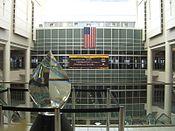
The city's primary airport, Port Columbus International Airport, is located on the east side of the city, with several smaller airports in the region as well. Port Columbus provides service to Toronto, Canada and Cancun, Mexico (on a seasonal basis), as well as to most domestic destinations, including all the major hubs except San Francisco and Seattle. Port Columbus was a hub for discount carrier Skybus Airlines and continues to be a home to NetJets, the world's largest fractional ownership air carrier. According to a 2005 market survey, Port Columbus International Airport attracts about 50% of its passengers from outside of its 60-mile (97 km) radius primary service region. Port Columbus is currently the 52nd-busiest airport in the United States by total passenger boardings. Rickenbacker International Airport, in southern Franklin County, is a major cargo facility and is utilized by the Ohio Air National Guard. OSU Don Scott Airport and Bolton Field are significant general-aviation facilities in the Columbus area.
Currently, Columbus lacks any type of passenger rail service.
Columbus used to have a major train station downtown called Union Station, most notably as a stop along Amtrak's National Limited train service until 1977. The station itself was razed in 1979, and the Greater Columbus Convention Center now stands in its place. The station was also a stop along the Cleveland, Columbus and Cincinnati Railroad and the Pittsburgh, Cincinnati, Chicago and St. Louis Railroad. Columbus is now the largest metropolitan area in the U.S. without either a local rail or intercity rail connection (Phoenix opened a light-rail system in 2008, but still lacks an Amtrak connection. Other metro areas larger than Columbus also lack local rail systems.); however studies are underway towards reintroducing passenger rail service to Columbus via the Ohio Hub project. Plans are in the works to open a high-speed rail service connecting Columbus with Cincinnati and to the proposed hub in Cleveland which offers rail service to the East Coast, including New York and Washington, DC.[100]
Columbus maintains a widespread municipal bus service called the Central Ohio Transit Authority (COTA).
Bicycling as transportation is steadily increasing in Columbus with its relatively flat terrain, intact urban neighborhoods, large student population, and off-road bike paths. The city has put forth the 2012 Bicentennial Bikeways Plan as well as a move toward a Complete Streets policy.[101] Grassroots efforts such as Bike To Work Week, Consider Biking, Yay Bikes,[102] Third Hand Bicycle Co-op, Franklinton Cycleworks, and Cranksters, a local radio program focused on urban cycling,[103] have contributed to cycling as transportation.
Columbus also hosts urban cycling "off-shots" with messenger-style "alleycat" races as well as unorganized group rides, a monthly Critical Mass ride,[104] bicycle polo, art showings, movie nights, and a variety of bicycle-friendly businesses and events throughout the year. All this activity occurs despite Columbus's frequently inclement weather.
The new Main Street Bridge features a dedicated bike and pedestrian lane separated from traffic, as will the Rich Street Bridge when it opens in 2011.
A 2011 study by Walk Score ranked Columbus 29th most walkable of fifty largest U.S. cities.[105]
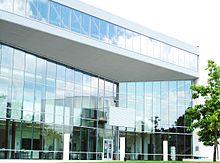
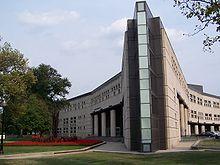
Columbus is the home of two public colleges: The Ohio State University, one of the largest college campuses in the United States, and Columbus State Community College. In 2009, The Ohio State University was ranked No. 19 in the country by U.S. News and World Report for best public university, and No. 56 overall, scoring in the first tier of schools nationally.[106] Some of OSU's graduate school programs placed in the top 5, including: No. 5 for best veterinary program and No. 5 for best pharmacy program. The specialty graduate programs of social psychology was ranked No. 2, dispute resolution was ranked No. 5, vocational education No. 2, and elementary education, secondary teacher education, administration/supervision No. 5.[107]
Private institutions located in Columbus include Capital University Law School, the Columbus College of Art and Design, Fortis College, DeVry University, Ohio Business College, Miami-Jacobs Career College, Ohio Institute of Health Careers, Bradford School and Franklin University, as well as the religious schools Bexley Hall Episcopal Seminary, Mount Carmel College of Nursing, Ohio Dominican University, Pontifical College Josephinum, and Trinity Lutheran Seminary. Three major suburban schools also have an influence on Columbus' educational landscape: Bexley's Capital University, Westerville's Otterbein University, and Delaware's Ohio Wesleyan University.
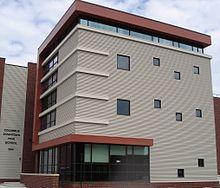
Columbus City Schools (CCS), formerly Columbus Public Schools, is the largest district in Ohio, with 55,000 pupils.[108] CCS operates 142 elementary, middle, and high schools, including a number of alternative schools. The suburbs operate their own districts as well, typically serving students in one or more townships, with districts sometimes crossing municipal boundaries. The Roman Catholic Diocese of Columbus also operates numerous parochial elementary and high schools. The second largest school district in the area is South-Western City Schools, which encompasses southwestern Franklin County. There are also several private schools in the area.
Some sources claim that the first kindergarten in the United States was established here by Louisa Frankenberg, a former student of Friedrich Frobel. Frankenberg immigrated to the city in 1838. In addition, Indianola Junior High School became the nation's first junior high in 1909, helping to bridge the difficult transition from elementary to high school at a time when only 48% of students continued their education after the 9th grade.[109]
The Columbus Metropolitan Library (CML) has been serving residents of central Ohio since 1873. With a collection of 3 million items, the system has 22 locations throughout the area. This library is one of the most-used library systems in the country and is consistently among the top-ranked large city libraries according to "Hennen aos American Public Library Ratings." CML was rated the No. 1 library system in the nation in 1999, 2005, and 2008. It has been in the top four every year since 1999 when the rankings were first published in American Libraries magazine, often challenging up-state neighbor Cuyahoga County Public Library for the top spot.[110][111] CML was named Library of the Year by the Library Journal in 2010.
Columbus is home to several notable buildings, including the Greek Revival State Capitol, the art-deco Ohio Judicial Center and the Peter Eisenman-designed Wexner Center and Greater Columbus Convention Center. Other buildings of interest include the Rhodes State Office Tower, LeVeque Tower, and One Nationwide Plaza.
The Ohio Statehouse construction began in 1839 on a 10 acre (40,000-m ²) plot of land donated by four prominent Columbus landowners. This plot formed Capitol Square, which was not part of the original layout of the city. Built of Columbus limestone from the Marble Cliff Quarry Co., the Statehouse stands on foundations 18 feet (5.5 m) deep, laid by prison labor gangs rumored to have been composed largely of masons jailed for minor infractions.[112] The Statehouse features a central recessed porch with a colonnade of a forthright and primitive Greek Doric mode. A broad and low central pediment supports the windowed astylar drum under an invisibly low saucer dome that lights the interior rotunda. Unlike many U.S. state capitol buildings, the Ohio State Capitol owes little to the architecture of the national Capitol. During the long course of the Statehouse's 22 years of construction, seven architects were employed. Relations between the legislature and the architects were not always cordial: Nathan B. Kelly, who introduced heating and an ingenious system of natural forced ventilation, was dismissed because the commissioners found his designs too lavish for the original intentions of the committee. The Statehouse was opened to the legislature and the public in 1857 and finally completed in 1861. It is located at the intersection of Broad and High Streets in downtown Columbus.
Founded in 1975, The Jefferson Center for Learning and the Arts is a campus of nonprofit organizations and a center for research, publications, and seminars on nonprofit leadership and governance. Located at the eastern edge of downtown Columbus, The Jefferson Center has restored 11 turn-of-the-century homes, including the childhood residence of James Thurber. These locations are used for nonprofits in human services, education and the arts.[113]
A to-scale replica of the Santa Maria is found on the Scioto Riverfront. It was installed in 1992 to commemorate the 500-year anniversary of the discovery of America by Columbus' namesake.
Within the Driving Park heritage district lies the original home of Eddie Rickenbacker, the famous WWI fighter pilot ace. Reconstruction of the home is underway.
Established in 1848, Green Lawn Cemetery is one of the largest cemeteries in the Midwestern United States.

The Ohio Statehouse, Capitol Square

LeVeque Tower, downtown
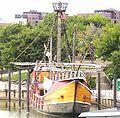
Replica of Christopher Columbus's ship, The Santa Maria, downtown riverfront

Franklin Park Conservatory, Franklin Park
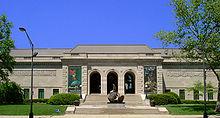
The Columbus Museum of Art opened in 1931, and has a collection focusing on European and American art up to early modernism. The Wexner Center for the Arts, a contemporary art gallery and research facility, is located on the Campus of The Ohio State University. Also on campus is the Ohio State University Athletics Hall of Fame, located in the Jerome Schottenstein Center (home of the OSU basketball and men's ice hockey teams), as well as the Jack Nicklaus museum next door.
Located in Franklin Park, the Franklin Park Conservatory is a botanical garden which opened in 1895, situated on 88 acres (36 ha) just east of Downtown.
COSI, (Center of Science and Industry), is a large science museum. The present building, the former Central High School, was completed in November 1999, opposite downtown on the west bank of the Scioto River. In 2009, Parents magazine named COSI one of the ten best Science Centers for families in the country.[114]
The Ohio Historical Society is headquartered in Columbus, with its flagship museum, the 250,000-square-foot (23,000 m2) Ohio Historical Center, located 4 mi (6.4 km) north of downtown. Along with the museum is Ohio Village, a replica of a village around the time of the American Civil War.
The Kelton House Museum and Garden is a museum devoted to Victorian life. Built in 1852, it was home to three generations of the Kelton Family and was a documented station on the Underground Railroad. In 1989, Columbus hosted the "Son of Heaven: Imperial Arts of China," a cultural exchange display from China featuring the artifacts of the ancient Chinese emperors.
According to Sperling's, 37.6% of Columbus residents are religious. Of this group, 15.7% identify as Protestant, 13.7% as Catholic, 1.5% as Jewish, 0.6% as Muslim, and 0.5% as Mormon.[115] Places of worship include Xenos Christian Fellowship, Vineyard Columbus, Trinity Episcopal Church, the Glenwood United Methodist Church, Broad Street United Methodist Church, Second Presbyterian Church, St. Paul's Episcopal Church, Shiloh Baptist Church, Roman Catholic Church's St. Joseph's Cathedral, the Greek Orthodox Church's Annunciation Cathedral, Mormon Columbus Ohio Temple, the Muslim Noor Islamic Cultural Center, and the Reform Jewish Temple Israel, the oldest synagogue in Columbus, Life Church at Easton in NE Columbus.
Megachurches include the World Harvest Church located in a southeast suburb.
Religious teaching institutions include the Trinity Lutheran Seminary, Bexley Hall Episcopal Seminary, Methodist Theological School in Ohio, and the Pontifical College Josephinum.

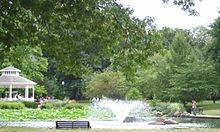
The Columbus and Franklin County Metropolitan Park District includes Inniswood Metro Gardens, a collection of public gardens; Highbanks Metro Park; Battelle-Darby Creek Metro Park; as well as many others. The Big Darby Creek in the southwestern part of town is considered to be especially significant for its beauty and ecological diversity.[116] Clintonville is home to Whetstone Park, which includes the Park of Roses, a beautiful 13-acre (53,000 m2) rose garden. The Chadwick Arboretum is located on the OSU campus, and features a large and varied collection of plants. Downtown, the famous painting Sunday Afternoon on the Island of La Grande Jatte is represented in topiary at Columbus's Old Deaf School Park. Also near downtown, a new Metro Park on the Whittier Peninsula is scheduled opened in 2009. The park includes a large Audubon nature center focused on the excellent bird watching that the area is known for.[117]
The Columbus Zoo and Aquarium is world renowned for its collections that include lowland gorillas, polar bears, manatees, Siberian tigers, cheetahs, and kangaroos. Its director emeritus, Jack Hanna, frequently appears on national television, including on The Tonight Show and the Late Show with David Letterman. In 2009, it was ranked as the best zoo in the United States. Also in the zoo complex is the Zoombezi Bay water park and amusement park.
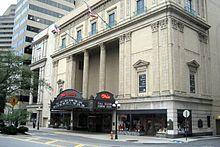
Columbus is the home of many renowned performing arts institutions including the Columbus Symphony Orchestra, Opera Columbus, BalletMet Columbus, the ProMusica Chamber Orchestra, CATCO, Columbus Children's Theatre, Shadowbox Cabaret and the Columbus Jazz Orchestra. Throughout the summer Actors Theatre of Columbus offers free performances of Shakespearean plays in an open-air amphitheatre in Schiller Park, located in historic German Village.
The Columbus Youth Ballet Academy was founded in the 1980s by internationally celebrated ballerina and artistic director Shir Lee Wu, a discovery of Martha Graham. Wu is now the artistic director of the Columbus City Ballet School, while her instruction remains in strong demand globally. Her students of the last couple decades have furthered their education at institutions such as The Juilliard School, School of American Ballet, Houston Ballet Academy, and Pacific Northwest Ballet Ballet School, while some have gone on to perform with companies including the New York City Ballet, Pacific Northwest Ballet, Martha Graham Contemporary Dance Company, and BalletMet Columbus. Her students have won gold medals at the Youth American Grand Prix competition in New York, while others have been finalists in competitions such as the Concord De Dance de Paris.[118]
There are many large concert venues in Columbus, including arenas such as Nationwide Arena and Jerome Schottenstein Center. The Lifestyle Communities Pavilion (the LC for short) (formerly the PromoWest Pavilion), Veterans Memorial Auditorium, Mershon Auditorium, and the Newport Music Hall round out the city's music performance spaces.
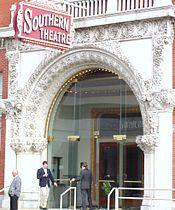
In May 2009, the Lincoln Theatre, which was formerly a center for Black culture in Columbus, was reopened to the public after extensive restoration.[119][120] Not far from the Lincoln Theatre is the King Arts Complex, which hosts various cultural events. The city also has a number of theatres downtown, including the historic Palace Theatre, the Ohio Theatre, and the Southern Theatre. Broadway Across America frequently presents touring Broadway musicals in these larger venues.[121] The Vern Riffe Center for Government and the Arts houses the Capitol Theatre and three smaller studio theatres, providing a home for resident performing arts companies.
Academy Award-winning movies filmed in Columbus and the central Ohio area include Steven Soderberg's Traffic in 2000 and Jonathan Demme's The Silence of the Lambs in 1991. The Shawshank Redemption was nominated for an Academy Award and was filmed at central Ohio locations in 1994. Other movies filmed in Columbus and the central Ohio area include Horrors of War (by local filmmakers Peter John Ross, John Whitney, and producer Philip R. Garrett) in 2006, Fallen Angels in 2006, Steven Soderberg's Bubble in 2005, Criminal Minds in 1998, Wolfgang Petersen's Air Force One in 1997, Tango & Cash in 1989, Speak in 2004, and Teachers in 1984.[122]
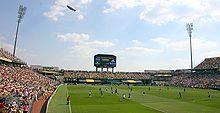
Columbus has professional sports teams in hockey, soccer, and minor league baseball. The Columbus Blue Jackets of the National Hockey League play at Nationwide Arena. The Columbus Bullies were two-time champions of the American Football League (1940 ae1941); the Columbus Thunderbolts were formed in 1991 for the AFL, and then relocated to Cleveland as the Cleveland Thunderbolts. The Columbus Destroyers were the next team of the Arena Football League, playing from 2004 until the league's demise in 2008. The Columbus Crew of Major League Soccer play at their own stadium, Columbus Crew Stadium, which was the first Soccer-specific stadium built in the United States. The Crew were one of the original members of the MLS, and have recently won their first MLS Cup in 2008. The Columbus Clippers, Triple A affiliate of the Cleveland Indians (formerly a long-time affiliate of the New York Yankees through 2006, and the Washington Nationals through 2008), previously hosting their games at Cooper Stadium but now play in a new ballpark in the Arena District named Huntington Park, which opened in April 2009. Until the arrival of the Columbus Crew in 1996, Columbus was the largest city in the United States without a franchise in a major professional sports league, a distinction now held by the city of Austin, Texas.
The city was home to the Tigers football team from 1901 ae1926.[123] In the 1990s the Columbus Quest won the only two championships during American Basketball League's existence.
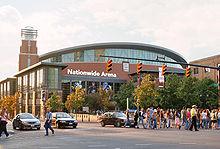
Columbus hosts the annual Arnold Classic fitness expo and competition in early March. Hosted by Arnold Schwarzenegger, the event has grown to eight Olympic sports and 12,000 athletes competing in 20 events. Schwarzenegger has been visiting Columbus for almost 40 years, and has substantial commercial investments in the metropolitan area.[124] In conjunction with the Arnold Classic, the city hosted three consecutive Ultimate Fighting Championships events between 2007 ae2009.[125] As well as other mixed martial arts events including, IFC Caged Combat, King of the Cage: Bragging Rights, and WEC 47, with plans for an upcoming Strikeforce event at Nationwide Arena in March 2011.
Automotive racing star Jeff Gordon's company, Jeff Gordon Inc., along with Arshot Investment Corp., have plans to construct the Center for Automotive Research & Technology at Cooper Park, a proposed racing venue and center just west of downtown.[126] Rahal Letterman Lanigan Racing, a business venture owned by Indianapolis 500 winner Bobby Rahal, television personality David Letterman, and entrepreneur Mike Lanigan, is based in the Columbus metropolitan area.
Columbus has a long history in motorsports, hosting the world's first 24 hour car race at the Columbus Driving Park in 1905, organized by the Columbus Auto Club.[127] The Columbus Motor Speedway was built in 1945 and held their first motorcycle race in 1946. In 2010 the Ohio State University student-built Buckeye Bullet 2, a fuel cell vehicle, set a FIA world speed record for electric vehicles in reaching 303.025 mph, eclipsing the previous record of 302.877 mph.[128]
The annual All American Quarter Horse Congress, the largest single breed horse show in the world[129] is held at the Ohio Expo Center each October and attracts approximately 500,000 visitors annually.
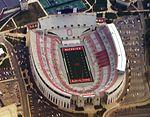
Columbus is home to Ohio State University athletics, one of the most competitive collegiate programs in the nation. The institution has placed in the top-10 final standings of the Director's Cup, headquartered in Cleveland, five times since 2000 ae2001, including #3 for the 2002 ae2003 season, #4 for the 2003 ae2004 season, while being ranked #2 toward the close of the 2009 ae2010 season before ultimately finishing #8.[131] The university fully funds 36 varsity teams, consisting of 17 male, 16 female, and three co-educational teams.[132] In 2007 ae2008 and 2008 ae2009, the program generated the second-most revenue for college programs behind the University of Texas.[133][134]
The Ohio State Buckeyes are a member of the NCAA's Big Ten Conference, and the football team plays home games at Ohio Stadium. The OSU-Michigan football game (known colloquially as "The Game") is the final game of the regular season and is played in November each year, alternating between Columbus and Ann Arbor, Michigan. In 2000, ESPN ranked the OSU-Michigan game as the greatest rivalry in North American sports.[135] Moreover, "Buckeye fever" permeates Columbus culture year-round and forms a major part of Columbus's cultural identity. Businessman and former New York Yankees owner George Steinbrenner, an Ohio native who studied at Ohio State at one point and who coached in Columbus, was a big Ohio State football fan and donor to the university, having contributed for the construction of the band facility at the renovated Ohio Stadium, which bears his family's name.[136]
During the winter months, the Buckeyes basketball team and hockey team are also a major sporting attraction.
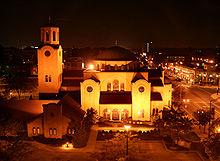
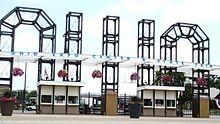
Annual festivities in Columbus include the Ohio State Fair aeone of the largest state fairs in the country ae as well as the Columbus Arts Festival and the Jazz and Ribs Festival, both of which occur on the downtown riverfront.
June is a popular festival month in Columbus. During the first weekend in June, the bars of Columbus's trendy North Market District play host to Park Street Festival. The event attracts thousands of visitors from the surrounding neighborhoods and beyond, creating a massive party both inside the bars and on the street. The second to last weekend in June is a one of the largest Gay Pride Parades in the midwest, reflective of the sizeable gay population in Columbus. During the last weekend of June, ComFest (short for "Community Festival") is an immense three-day music festival, the largest non-commercial festival in the U.S., in Goodale Park with art vendors and live musicians on multiple stages, hundreds of local social and political organizations, body painting and beer.
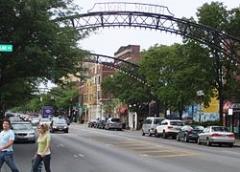
The Hot Times festival is held annually in Columbus's historic Olde Towne East neighborhood ae a celebration of music, arts, food, and diversity.
Restaurant Week Columbus is the city's largest dining event, held for a week in mid-July and mid-January each year. This popular event featured over 40 restaurants in January 2010. Over 40,000 diners went out during the week culminating with a $5,000 donation made to the Mid-Ohio Food bank on behalf of sponsors and participating restaurants.[137]
The JuneteenthOhio Festival is held each year at Franklin Park on Father's Day weekend. JuneteenthOhio is one of the largest African-American festivals in the United States, started 19 years ago by Mustafaa Shabazz. The festival is three full days of music, food, dance, and entertainment by local and national recording artists. The festival holds a Father's Day celebration, honoring local fathers.
Around the Fourth of July, Columbus hosts Red, White, and Boom! on the Scioto riverfront downtown to crowds of over 500,000 people.[138] The popular Doo Dah Parade is held at this time, as well.
During Memorial Day Weekend, the well-attended Asian Festival is held in Franklin Park. Hundreds of restaurants, vendors, and companies open up booths, traditional music and martial arts are performed, and cultural exhibits are set up. In recent years, attendees have numbered over 100,000.
The Jazz and Rib Fest is a free downtown event held each July featuring jazz artists like Randy Weston, D. Bohannon Clark, and Wayne Shorter, along with rib vendors from around the country.
The Short North is host to the monthly "Gallery Hop", which attracts hundreds to the neighborhood's art galleries (which all open their doors to the public until late at night) and street musicians. The Hilltop Bean Dinner is an annual event held on Columbus's West Side that celebrates the city's Civil War heritage near the historic Camp Chase Cemetery. At the end of September, German Village throws an annual Oktoberfest celebration that features authentic German food, beer, music, and crafts.
Columbus also hosts many conventions in the Greater Columbus Convention Center, a pastel-colored deconstructivist building on the north edge of downtown that resembles jumbled blocks, or a train yard from overhead. The convention center was designed by famed architect Peter Eisenman, who also designed the aforementioned Wexner Center. Completed in 1993, the convention center now has 1,700,000 square feet (160,000 m2) of space.[139]
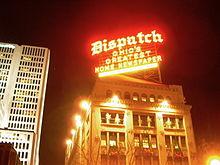
Columbus was ranked in 2009 as the 18th best place in the country to find a date for females by Marie Claire Magazine,[140] and was ranked as the No. 2 most sexually satisfied city in the country in 2008, according to Men's Health Magazine, behind Indianapolis,[141] and also ranked as the No. 7 most lustful in the country in 2007, based on contraceptive sales, according to Forbes Magazine.[142]
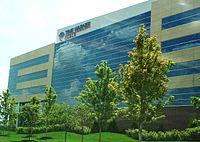
Columbus's sole remaining daily newspaper is The Columbus Dispatch; its erstwhile main competitor, The Columbus Citizen-Journal, ceased publication on December 31, 1985. There are also a number of weekly newspapers, including neighborhood/suburb specific papers such as Suburban News Publications which serves 23 suburbs and Columbus; The Daily Reporter, central Ohio's only daily business and legal newspaper; UWeekly which serves the OSU community; ThisWeek; and "alternative" arts/culture/politics-oriented papers such as The Other Paper, Outlook (of interest to the LGBT community in Columbus) and aLIVE (formerly the independent Columbus Alive, and now owned by the Columbus Dispatch). C: The mostly monthly Columbus Magazine, CityScene, and Columbus Monthly are the city's magazines. The newest addition to the Columbus media scene is (614) Magazine, a free, monthly that focuses on the 25 ae40 demographic. The city's business community is also served by Columbus Business First, a weekly business publication that is part of the Charlotte-based American City Business Journals, which have business papers in cities across the U.S. Extensive Statehouse coverage is provided by Gongwer News Service, a daily independent political newsletter.
Columbus is home to the 36th largest radio market.[143] The following box contains all of the radio stations in the area:
Word Count: 9771






